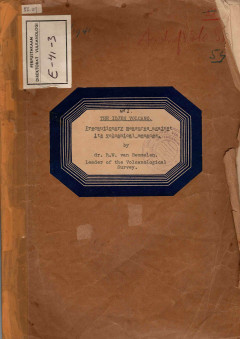Ditapis dengan

The Idjen Volcano
The idjen volcano has a crater lake containing en 36 million m³ of highly acid, hot water.1) this crater lake forms a peranent menace for the surrounding region. Fruptions of the idjen volcano may throw out this huge volume of poisonous hot water, causing calamities by devastating lahars. This occurred for instance in 1817.
- Edisi
- -
- ISBN/ISSN
- -
- Deskripsi Fisik
- 13 hml.; gmbr
- Judul Seri
- -
- No. Panggil
- PVG E.41-3

Outbursts Of The Lamongan The Dry And Eainy Seasons., The Volcano-Tectonic St…
During the following investigation below after the connection between eruptive phenomena and rain fall on the sunsit of the Lamongan, as such an ponsible, I have counted together those outbursts, which are known as such in the literature, although a fow older reports, which indicate increased activity, which is only observed from a distance and is not knows whether ash has been ejected, are per…
- Edisi
- -
- ISBN/ISSN
- -
- Deskripsi Fisik
- 10 hml.; tabel
- Judul Seri
- -
- No. Panggil
- PVG E.37-5

Paleomagnetic Measurement and Radiometric'' Dating of the Volcanic Material a…
Present situation of the Sumatra Island seems to indicate the clockwise rotation of about 40 degrees for Jawa (Fig.1). Ninkovich (1970) proposed a hypothesis that in the Late Cenozoic Sumatra rotated clockwise about 20 degrees and formed the present configuration. Moreover, Sasajima et al (1980) said that after the Triassic until the Early Tertiary, Sumatra should have rotated clockwise by 62.4…
- Edisi
- -
- ISBN/ISSN
- -
- Deskripsi Fisik
- 19 hlm; tabel; gmbr; peta
- Judul Seri
- -
- No. Panggil
- PVG A.83-36

The Renewed Activity of Krakatau Volcano After its Catastrophic Eruption in 1883
Krakatau voleano which is located at Sunda Strait, Indonesia, catastrophic The is a wellknown volcano in the world, because of its eruption in August 1883, and submarine caldera came into existence. Relatively in a short time, fortyfour years later, in Docamber 1927, ronewed activity was begun, started by submarine oxplosions. eruption was a commencement for the first periode of a now cycle of …
- Edisi
- -
- ISBN/ISSN
- -
- Deskripsi Fisik
- 19 hlm; gmbr;peta
- Judul Seri
- -
- No. Panggil
- PVG A.83-44

Increase in Seismic Activity in 1995 - 1996 at Lokon Volcano, Sulawesi Utara
Lokon is volcano complex, north Sulawesi, Indonesia. The Eruptive activity at the volcano has been repeated at Tompaluan crater with time interval of 1-8 years in recent 50 years. The last eruption occurred in1991
- Edisi
- -
- ISBN/ISSN
- -
- Deskripsi Fisik
- 24hlm; gbr
- Judul Seri
- -
- No. Panggil
- PVG S.96-16

The Morfhological Development of Krakatau Volcano Sunda Strait, Indonesia
Krakatau volcano located in Sunda Strait between Suamtra and Jawa is worldwide known because of the destructive Plinian eruption that took place in 1813. The erupstion effect was felt all over was felt all over the world; seawaves travelled as far as 22,000 km reaching the south american pasific coast and indian coast of africa while volcanic ashes were ejected up to the height of 90 km that tr…
- Edisi
- -
- ISBN/ISSN
- -
- Deskripsi Fisik
- 17 hlm; tabel; gmbr; peta
- Judul Seri
- -
- No. Panggil
- PVG A.81-4

Wedusgembel Of The Merapi Volcano In 1920
On October 12, 1920 the inhabitants of the most high laying kampungs in the vicinity of the Blongkengravine were surprised by hot dustclouds and were killed by the burns. It appeared inmediately, that there was no outburst at all, as the summit slopes of the Merapi were, as far as they were overgrown in August and September, were still green as before (the reports from news papers concerning th…
- Edisi
- -
- ISBN/ISSN
- -
- Deskripsi Fisik
- 9 hml
- Judul Seri
- -
- No. Panggil
- PVG E.21-3

The Craterlake of Kelut Volcano
As far as we can conclude from the volcanical history of the G.Kelut, after each out burst a craterlake was formed (Portrait of the Craterlake anong others in 'Geweldige Natuurkrachten' by Vissering in J.v.h. Mijnwezen 1907, Verhandeling Hugo Cool and a.m.). As most of the strate volcanoes has no craterlake there must be extraordinary conditions present, when at such volcano body craterlakes…
- Edisi
- -
- ISBN/ISSN
- -
- Deskripsi Fisik
- 4 hml
- Judul Seri
- -
- No. Panggil
- E.21-2

The 1885 Disaster of Semeru Volcano
In 1885 a part of the southen collapse due to the pressure of the lava in the Semeru
- Edisi
- -
- ISBN/ISSN
- -
- Deskripsi Fisik
- 5hlm
- Judul Seri
- -
- No. Panggil
- PVG E.24-2

The Rock of The Lamongan Volcano.
In accordance with Lorie and Prof. Behrens we have determined all collected samples as real basalts. The microscopic praeparates only show difference in relative number and size of the separated crystalls between them, and with respect to the groundmass, also in his capacity of the groundmass itself. As conson with basalt, the olivine exclusively appears as porphyric separation and not in the g…
- Edisi
- -
- ISBN/ISSN
- -
- Deskripsi Fisik
- 4 hml
- Judul Seri
- -
- No. Panggil
- PVG E.086-1
 Karya Umum
Karya Umum  Filsafat
Filsafat  Agama
Agama  Ilmu-ilmu Sosial
Ilmu-ilmu Sosial  Bahasa
Bahasa  Ilmu-ilmu Murni
Ilmu-ilmu Murni  Ilmu-ilmu Terapan
Ilmu-ilmu Terapan  Kesenian, Hiburan, dan Olahraga
Kesenian, Hiburan, dan Olahraga  Kesusastraan
Kesusastraan  Geografi dan Sejarah
Geografi dan Sejarah